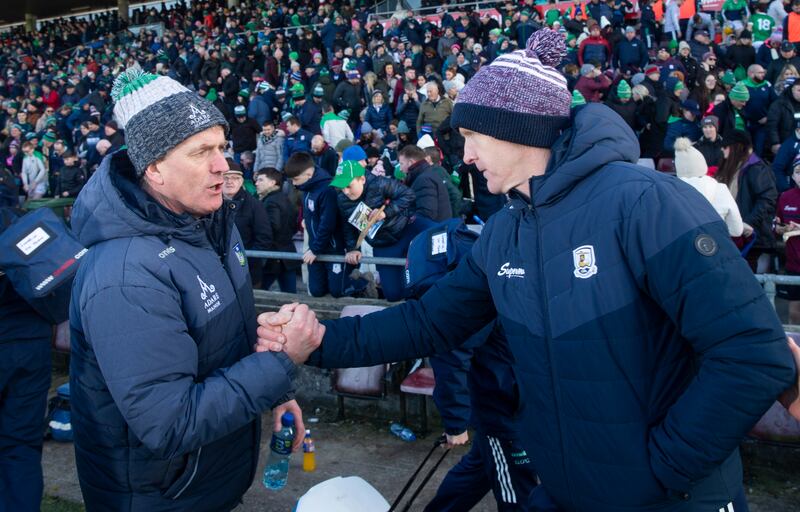Most of us are familiar with the experience of being unable to focus on a sporting event that’s happening on television in front of us without checking our phone every three or four minutes. I don’t think I’ve ever watched an entire sporting competition in that frame of mind, but this year’s National Hurling League has got to be the closest I’ve ever got.
Galway and Clare last Sunday was just so instantly forgettable, such a pale shadow of what hurling can be and has to be. Robbed of bite and intensity, the ball got pinged around from one end of the field to the other as we waited in vain for someone to put a tackle in.
This is how most of the hurling counties want it, of course. This is exactly as it’s been designed. If some isolated pockets of hurling break out, as happened in Thurles on Saturday night, it’ll serve as a nice reminder of what the sport is supposed to look like, but no one is taking that too seriously.
Henry Shefflin and John Kiely laughing and joking with each other on the sideline in Salthill two weeks ago, while the game was still in the melting pot, was probably the defining image of the league thus far.
‘There’s no control in games anymore’: Darragh Ó Sé, Dean Rock and Conor McManus chat about the 2025 All-Ireland
Cork could confirm their rise by blasting their way past Tipperary
Laois dominate Wexford in opening round of Leinster SFC
Munster SFC: Cork book semi-final showdown with Kerry after easy win over Limerick
And everyone saw this coming – hell, even I was writing in January about how the league takes up almost as much time as the championship to play, and yet gives us nothing.
Then, I suggested giving the entire month of February to the Fitzgibbon Cup, scrapping the league altogether, and replacing it with home and away games in the Munster and Leinster group stages; but, as ever, one idea spawns other, much better ideas.
Jamie Wall, well-known hurling analyst and coach of the Mary Immaculate College Fitzgibbon Cup team, wasn’t long in giving me some well-intentioned feedback. Instead of making the Munster and Leinster group stages home and away, as I had suggested, Jamie wanted to draw up two conferences of seven teams each, starting in March.
They would be drawn up from scratch each year, with teams from both provinces evenly divided to ensure that each conference remains even and competitive, and to ensure that counties keep playing as many different teams as possible.
Teams play each other home and away. The top three teams in each group would qualify for the All-Ireland championship. The winners of the two conferences would qualify for the All-Ireland semi-finals, and the teams placed second and third would play All-Ireland quarter-finals.

You will have some questions, I’m sure, primarily perhaps about the status of the Munster and Leinster championships. Jamie’s answer to that was ingenious. It takes three weekends to play off the two provincial championships. So if the conference group games start in March, you sprinkle in the provincial championship games like the FA Cup throughout a Premier League season.
You play the quarter-finals of the provincial championships on the May bank holiday weekend. You play the semi-finals on the June bank holiday weekend. And you play the provincial finals at the start of July between the All-Ireland quarter- and semi-finals.
They’re not linked to the All-Ireland championship at all, but they remain important, knock-out competitions in their own right, with teams out of the running for the All-Ireland able to regain a measure of success from the year with a provincial final win. And those games would redress the balance between knock-out games, which we all grew up watching and admiring, and the league play of the two conferences.
The reason for seven teams? That was illustrated most effectively just last weekend.
In Division 1B Antrim and Laois had one game they had to win to avoid relegation: the game against each other. Antrim had home advantage for it, and that might have been the deciding factor. If there are two seven-team conferences (instead of the six-team divisions in the league), then their season, and Laois’s season, and that of whoever else can force their way in, will not depend on beating the one other “weak” team in their vicinity, or indeed on the vagaries of being at home or away for that one fixture.
The five Munster counties, plus Galway, Kilkenny and Wexford, are currently a cut above. But would any of the teams named above be afraid of an awful trimming from Dublin at the moment? Depending on whether you put Dublin above or below that line, you’re looking at either six or five teams in the category of “development” teams.
They would take a few beatings, but they would also get a chance to play at least four games against teams they would fancy beating. And they’d be a part of the big show. The bottom teams in each group would play a relegation playoff, and one team would be promoted.
Seven-team conferences would necessitate an early March start, and maybe a late July finish. If that was too tight (keeping in mind every team in a seven-team league would have two bye weeks), then even six-team conferences would be worth experimenting with. Anything but what we’ve been watching recently.
People who would try to tell you that the league isn’t in such a bad shape might tell you to look at the crowds this year, which on the main have continued to look fairly healthy. I’d be inclined to say that if they’ll turn out for this sham, imagine how interested they’d be in hurling that actually mattered in spring?














